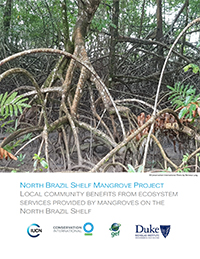This analysis seeks to evaluate the size and distribution of the services the mangrove ecosystem is providing to local communities in Suriname and Guyana. The study involves three components: (i) the description, from the scientific and grey literatures, of the mangrove ecosystem services specific to local communities in Guyana and Suriname; (ii) identification of methods that could be used to estimate the economic values of these services, and estimation of the economic values for mangrove forests’ fisheries support ecosystem service; and (iii) identification of local beneficiaries of these services.
The following ecosystem services were identified for Guyana and Suriname: Aesthetics, culture, heritage and social values, health impacts, species existence, wood products, non-timber forest products, fish abundance (commercial and subsistence), recreational values, flood damage mitigation, shoreline property damage mitigation, protection of peatlands, and climate mitigation.
To facilitate future analyses, examples for benefit relevant indicators are provided as a first step toward economic valuation, and ecosystem services are matched to the appropriate economic valuation method from the literature. As an example for an ecosystem service provided by mangroves, capture fisheries and aquaculture are on a steady growth trajectory in both Guyana and Suriname, making them the top two countries in the CARICOM region for fisheries production. Using data assembled from multiple scientific publications on mangrove-fishery linkages, a regression model was estimated for finfish and shellfish catch, in which the shellfish, and abundance variables have positive regression coefficients that are statistically significant at a 0.01 significance level.
Based on the meta-analysis results, we estimated the monetary impact of mangrove loss on Guyanese and Surinamese fisheries. In both Guyana and Suriname, local community groups were identified that may be affected disproportionately due to future mangrove loss.
The present analysis provides four areas of application when developing or updating mangrove management plans. First, the conceptual framework developed helps determine the impact of policy and management changes on the amount of various mangrove ecosystem services flows. Second, the list of local community beneficiaries and their perceptions helps in determining the distributional impacts of changes in mangrove management, and highlights local beneficiary groups that are most highly dependent on mangroves. Third, the use of economic values estimated for the fisheries support ecosystem service can be used to improve management decisions by providing defensible positive values to better determine the relative costs and benefits of, and tradeoffs among alternative future scenarios. Fourth, to facilitate future mangrove ecosystem services valuation on the NBS, economic valuation methods are proposed for the ecosystem services relevant to Guyana and Suriname.


